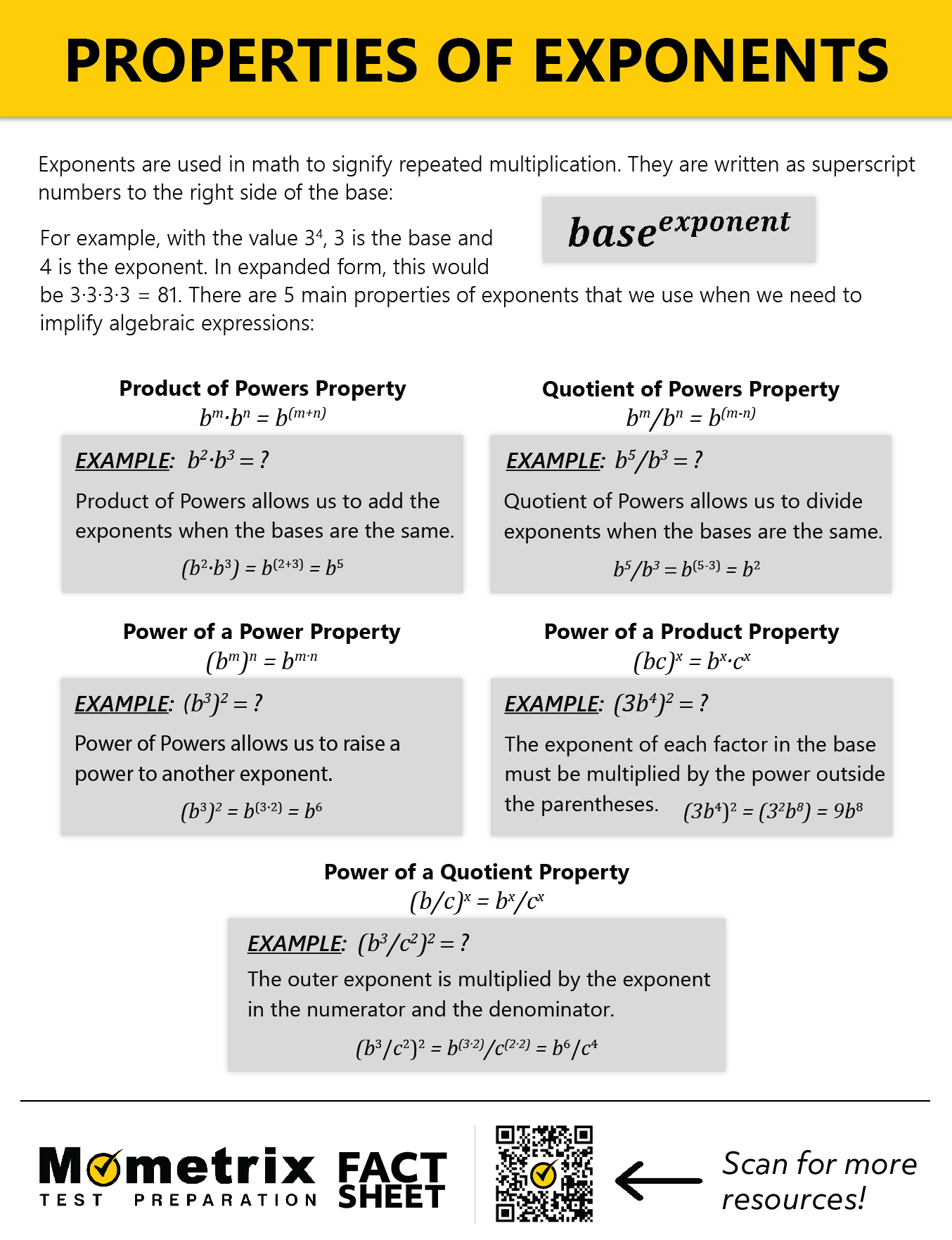
Hi, and welcome to this video on the laws of exponents!
Working with polynomial, radical, and rational functions often times requires us to perform algebraic operations with powers. Recall that a power is nothing more than a base that is raised to an exponent.
Let’s take a look at the properties of exponents that are used to simplify algebraic expressions with powers.
Product of Powers
The product of powers property applies to powers with the same base. When asked to multiply powers with the same base, simply add the exponents. For example:
This rule makes intuitive sense if you expand each power like this:
Counting up the bases of
Therefore, the general form of the product of powers rule is:
Quotient of Powers
The quotient of powers property also applies to powers with the same base; however, the rule requires the subtraction of exponents. Let’s look at an example:
Canceling out common factors of
The quotient of powers property allows a quicker, more efficient result. Simply subtract the exponent of the denominator from the exponent of the numerator:
The general form for quotient of powers property is:
Power of a Power
The power of a power property allows us to raise a power to another exponent. Once again, expanding an expression makes understanding the rule a bit easier. Suppose the power
In expanded form it would look like this:
The general form of this property is:
Power of a Product
Expanding on the power of a power property results in additional tools that are used to simplify expressions with powers.
For example, suppose the base of a power is a monomial with a coefficient and a variable.
This is called the power of a product property and illustrates that the exponent of each factor in the base must be multiplied by the power outside the parentheses.
The general form for the power of product property is:
Power of Quotient
The power of quotient property is similar in that the exponent of a rational base is multiplied by the exponents in both the numerator and denominator. Let’s look at some examples:
The product of powers property results in the simplified expression
However, applying the power of quotient property directly is often more efficient:
Here’s another example:
Rearranging factors and applying the product of powers property results in:
If we were to apply the power of quotient property, it would look like this:
The general rule for the power of quotient property is:
As you can see, these rules are essential in simplifying expressions within our work with various algebraic functions.
Thanks for watching this review covering the laws of exponents! Happy studying!
Frequently Asked Questions
Q
What is the formula for product of powers?
A
The product of powers rule says that when multiplying exponents with the same base, you can find the product by keeping the base and adding the exponents. For example, to find the product of
Q
What is the product of powers property?
A
The product of powers property or rule states that when multiplying exponents with the same base, you find the product by keeping the base and adding the exponents. The formula for the rule is
Q
What is an example of quotient of powers?
A
The quotient of powers rule states that when dividing exponents with the same base, we keep the base and subtract the exponents. The general formula for the rule is
Q
What is the quotient rule for exponents?
A
The quotient rule for exponents says, when dividing exponents with the same base, we keep the base and subtract the exponents. The general form of the rule is
Q
Can you have a power of a power?
A
Yes, you can have a power of a power. The power of a power rule says, when a number with an exponent is raised to another exponent, we can simplify the exponent by keeping the base and multiplying the exponents. The general form of the rule is
Q
What is the power of power rule in math?
A
The power of power rule states that when a number with an exponent is raised to another exponent, the expression can be simplified by keeping the base and multiplying the exponents. The general form of the rule is
Q
What is the power of product property?
A
The power of product property or rule states that if two numbers multiplied by one another are raised to a certain power, then each number is raised to that power and then the numbers are multiplied. The general form of the rule is
Q
What is the power of quotient property?
A
The power of quotient property states that if two numbers divided by one another are raised to a certain power, then each number is raised to that power and then the numbers are divided. The general form of the rule is
Laws of Exponents PDF
Laws of Exponents Practice Questions
Which of the following is a correct statement?
Which of the following statements is not true?

